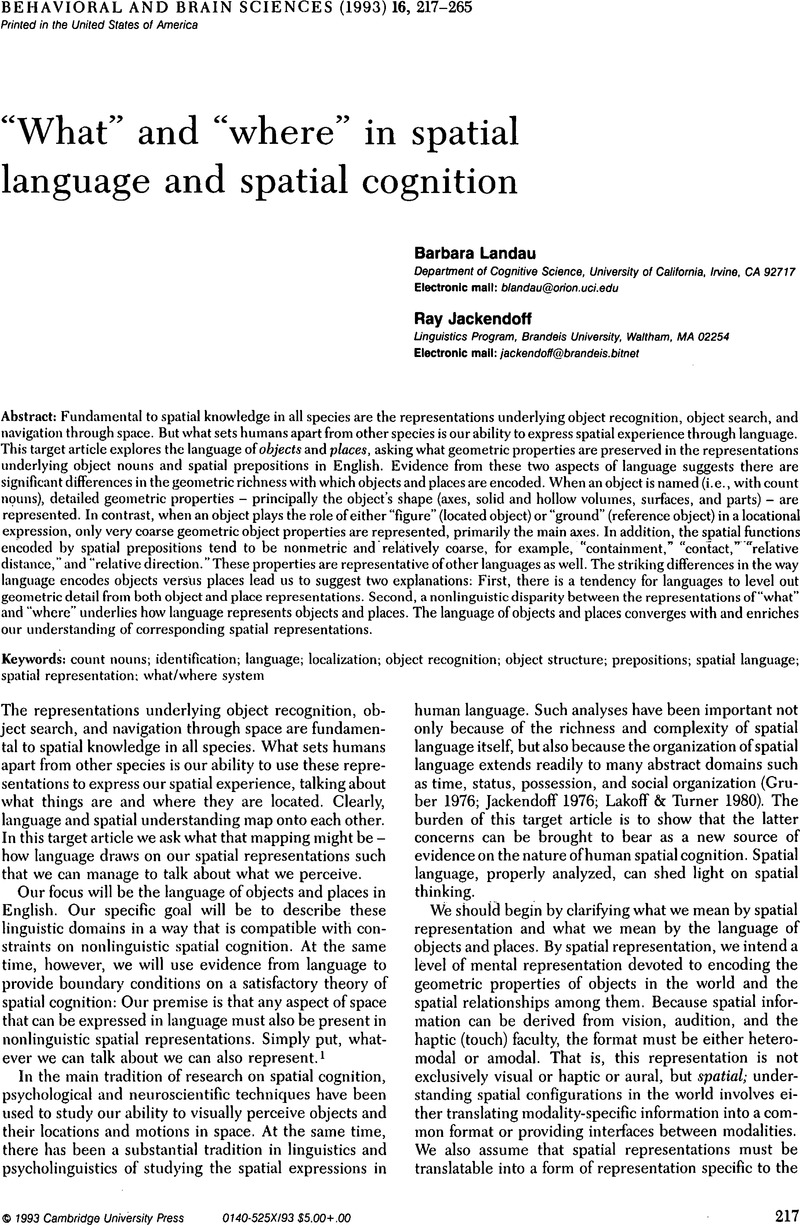Crossref Citations
This article has been cited by the following publications. This list is generated based on data provided by Crossref.
Wagner, Laura
2010.
The acquisition of semantics.
WIREs Cognitive Science,
Vol. 1,
Issue. 4,
p.
519.
Ankowski, Amber A.
Thom, Emily E.
Sandhofer, Catherine M.
and
Blaisdell, Aaron P.
2012.
Spatial Language and Children’s Spatial Landmark Use.
Child Development Research,
Vol. 2012,
Issue. ,
p.
1.
Dube, Matthew P.
and
Egenhofer, Max J.
2014.
Partitions to improve spatial reasoning.
p.
1.
Odic, Darko
Le Corre, Mathieu
and
Halberda, Justin
2015.
Children’s mappings between number words and the approximate number system.
Cognition,
Vol. 138,
Issue. ,
p.
102.
Majid, Asifa
Jordan, Fiona
and
Dunn, Michael
2015.
Semantic systems in closely related languages.
Language Sciences,
Vol. 49,
Issue. ,
p.
1.
Perera, Vittorio
Soetens, Robin
Kollar, Thomas
Samadi, Mehdi
Sun, Yichao
Nardi, Daniele
Van de Molengraft, René
and
Veloso, Manuela
2015.
Learning Task Knowledge from Dialog and Web Access.
Robotics,
Vol. 4,
Issue. 2,
p.
223.
Jimmy Li
Meger, David
and
Dudek, Gregory
2016.
Learning to generalize 3D spatial relationships.
p.
5744.
Yuan, Lei
Uttal, David
Franconeri, Steven
and
Mishra, Ramesh Kumar
2016.
Are Categorical Spatial Relations Encoded by Shifting Visual Attention between Objects?.
PLOS ONE,
Vol. 11,
Issue. 10,
p.
e0163141.
Lara, Graciela
De Antonio, Angélica
and
Peña, Adriana
2016.
Computerized spatial language generation for object location.
Virtual Reality,
Vol. 20,
Issue. 3,
p.
183.
Akhavan, Niloofar
Nozari, Nazbanou
and
Göksun, Tilbe
2017.
Expression of motion events in Farsi.
Language, Cognition and Neuroscience,
Vol. 32,
Issue. 6,
p.
792.
Muscat, Adrian
and
Belz, Anja
2017.
Learning to Generate Descriptions of Visual Data Anchored in Spatial Relations.
IEEE Computational Intelligence Magazine,
Vol. 12,
Issue. 3,
p.
29.
Lakusta, Laura
Spinelli, Danielle
and
Garcia, Kathryn
2017.
The relationship between pre-verbal event representations and semantic structures: The case of goal and source paths.
Cognition,
Vol. 164,
Issue. ,
p.
174.
Li, Peggy
and
Abarbanell, Linda
2018.
Competing perspectives on frames of reference in language and thought.
Cognition,
Vol. 170,
Issue. ,
p.
9.
Bharambe, Ujwala
and
Durbha, Surya S.
2018.
Adaptive Pareto-based approach for geo-ontology matching.
Computers & Geosciences,
Vol. 119,
Issue. ,
p.
92.
Egorova, Ekaterina
Moncla, Ludovic
Gaio, Mauro
Claramunt, Christophe
and
Purves, Ross S.
2018.
Fictive motion extraction and classification.
International Journal of Geographical Information Science,
Vol. 32,
Issue. 11,
p.
2247.
Stock, Kristin
and
Yousaf, Javid
2018.
Context-aware automated interpretation of elaborate natural language descriptions of location through learning from empirical data.
International Journal of Geographical Information Science,
Vol. 32,
Issue. 6,
p.
1087.
Newcombe, Nora S.
2018.
Stevens' Handbook of Experimental Psychology and Cognitive Neuroscience.
p.
1.
Eskikand, Parvin Zarei
Kameneva, Tatiana
Ibbotson, Michael R.
Burkitt, Anthony N.
and
Grayden, David B.
2018.
A biologically-based computational model of visual cortex that overcomes the X-junction illusion.
Neural Networks,
Vol. 102,
Issue. ,
p.
10.
Stock, Kristin
and
Hall, Mark
2018.
Proceedings of Workshops and Posters at the 13th International Conference on Spatial Information Theory (COSIT 2017).
p.
245.
Yang, Kaiyu
Russakovsky, Olga
and
Deng, Jia
2019.
SpatialSense: An Adversarially Crowdsourced Benchmark for Spatial Relation Recognition.
p.
2051.



